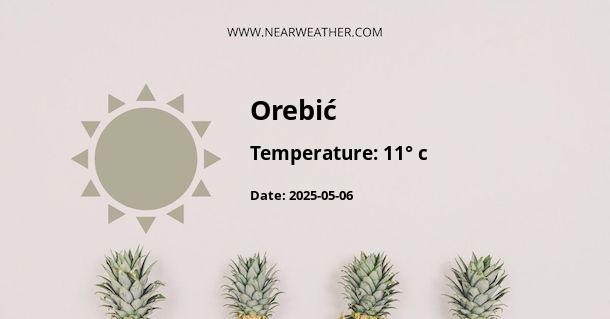An In-Depth Look at Orebić, Croatia: Climate and Weather Year-Round
The charming town of Orebić, located on the Pelješac Peninsula in Croatia, serves as a fascinating case study for the Mediterranean climate. This idyllic destination is a haven for travelers seeking both historical insight and an enjoyable climate year-round. In this comprehensive look at Orebić’s weather patterns, we will delve into the minutiae of what makes its climate particularly inviting for visitors and residents alike.
Geographical Influence on Climate
Orebić's geographical location plays a crucial role in its climate. Hugging the Dalmatian coast, the town is sheltered by Mount Ilija to the northeast, which contributes to its mild winters and warm summers. The influence of the adjacent Adriatic Sea cannot be overstated, as it moderates temperatures, limiting extreme seasonal variations.
Seasonal Temperature Overview
Orebić experiences a climate that is primarily classified as a Mediterranean climate, characterized by long, dry summers and mild, wet winters.
Summer (June - August)
Summer in Orebić is characterized by warm temperatures and a high degree of sunshine. Days are typically hot with temperatures often reaching above 30°C (86°F), while the evenings provide a cooling, comfortable respite.
Autumn (September - November)
With the arrival of autumn, temperatures in Orebić begin to decline slightly. September often still feels like summer, though by November, you can expect cooler temperatures, particularly at night, with averages ranging from 11°C (51.8°F) to 19°C (66.2°F).
Winter (December - February)
Cold spells during winter are rarely severe or prolonged in Orebić. Snow is an infrequent visitor to the town. Instead, the average temperature hovers between 5°C (41°F) and 12°C (53.6°F), coupled with increased precipitation levels.
Spring (March - May)
Spring sees a rejuvenation of warmth and life in Orebić. Temperatures steadily rise from the coolness of winter, averaging between 9°C (48.2°F) and 21°C (69.8°F) by the time May concludes.
Precipitation Patterns
Precipitation in Orebić, akin to other Mediterranean climates, is not distributed evenly throughout the year. The majority of rainfall occurs during the autumn and winter months, while summers remain markedly dry.
- Summer months may see as little as 25 mm (1 inch) of rain.
- Autumn, particularly November, marks the beginning of the wet season, with monthly rainfall averages reaching up to 119 mm (4.7 inches).
- Winter sees continued precipitation, coinciding with the lowest temperatures of the year.
- Spring witnesses a gradual decline in rainfall, setting the stage for the dry, sunny conditions of summer.
Wind Conditions
The coastal regions of Croatia, including Orebić, are influenced by local winds which have specific names and characteristics:
- Bora: A dry, cold, northeasterly wind that can occur during any time of year but is most common in winter. It often brings clear skies but lower temperatures and turbulent seas.
- Sirocco: A southeasterly wind that blows from the Sahara Desert across the Mediterranean, bringing warm, moist air and often rain. This wind is most common in autumn and spring.
- Mistral: A welcome northwesterly wind occurring on clear, sunny days, especially in summer, helping to provide relief from the heat. It typically starts in the morning and subsides at sunset.
Sunshine and Daylight Hours
Orebić is blessed with an abundance of sunshine year-round, averaging between 2,600 to 2,800 hours of sunshine annually. This abundance is particularly enjoyable during the summer when daylight stretches for more than 15 hours, from approximately 5:30 am to 8:30 pm.
Table of Climate Norms
| Month | Average High (°C) | Average Low (°C) | Average Precipitation (mm) |
|---|---|---|---|
| January | 12 | 5 | 95 |
| February | 12.5 | 5.5 | 80 |
| March | 14.5 | 7 | 75 |
| April | 18 | 10 | 65 |
| May | 22.5 | 14.5 | 55 |
| June | 26.5 | 18 | 45 |
| July | 30 | 21 | 26 |
| August | 30 | 21 | 44 |
| September | 26 | 17 | 85 |
| October | 21 | 13 | 100 |
| November | 16.5 | 9 | 119 |
| December | 13.5 | 6 | 110 |
Extreme Weather Events
While Orebić enjoys a relatively stable and temperate climate, it is not immune to extreme weather phenomena. Occasional heat waves can spike summer temperatures, at times surpassing 35°C (95°F). Conversely, rare cold snaps in winter can see temperatures fall to or below the freezing mark.
Climate Adaptations and Activities
The consistency of Orebić's climate has allowed the locals to adapt their activities and lifestyle seamlessly with the seasons. The mild winters lend themselves to outdoor activities, such as hiking in the nearby hills or exploring the town’s historical sites without the oppressive heat of summer.
The warm and dry summer months are ideal for water sports, beach-going, and vineyard visits, as Orebić is known for its exquisite wine production. The region's grapes thrive under the hot sun, adding economic and cultural value to Orebić's climate.
In conclusion, the climate of Orebić, Croatia, presents as idyllic for those seeking Mediterranean continuity with its warm, dry summers and mild, rainy winters. Understanding this climate can greatly enhance the experience of visitors and is a fundamental aspect that contributes to the allure of this Croatian gem.
A - Orebić's Latitude is 42.985561 & Longitude is 17.174721.
A - Weather in Orebić is 22° today.
A - Climate Conditions in Orebić shows clear sky today.
A - Humidity in Orebić is 64% today.
A - Wind speed in Orebić is 13.36 km/h, flowing at 267° wind direction. today.
